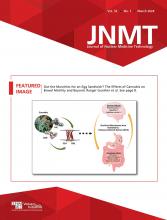Kathy S. Thomas, MHA, CNMT, PET, FSNMMI-TS
I would like to begin this editorial with a big “THANK YOU!” to those who took the time to respond to the 2023 JNMT Readership Survey. Your responses, candid comments, and suggestions will guide and develop the future content of JNMT. Beyond your “thumbs up” for the continuing education articles published in each issue, you provided a very positive response for the newer sections, including the Educators’ Forum, Practical Protocol Tips, and Practical Pointers. Readers liked the balance of scientific versus practical information and confirmed that published information was being used in the clinical setting to make changes, as necessary. You mentioned the need for authors to consider the diverse clinical settings around the world when discussing innovative technical and scientific information and how the varied clinical settings can apply that information. There were comments from a few readers noting the desire to receive a printed copy of JNMT rather than reading articles online. SNMMI-TS members can opt in to receive print copies of JNMT by contacting the membership office at memberinfo{at}snmmi.org.
The focus of this issue is the brainchild of our continuing education Associate Editor, Mary Beth Farrell. I will let Mary Beth describe her work with a dedicated group of nuclear medicine professionals to present the topic Gastrointestinal System Imaging:“I have a pet peeve (noun = personal grievance or vexation). My main gripe is noncompliance with the Society of Nuclear Medicine and Molecular Imaging guidelines and the consensus recommendations for gastric emptying scintigraphy (GES) (1,2). Nuclear medicine is all about physiology, and the only way to accurately and reliably assess physiology is through standardization.
In 2017, I coauthored a study published in the JNMT that looked at accredited laboratories’ compliance with the standardized GES protocol (3). Only 35% of laboratories followed the correct meal contents at that time. The variety of ridiculous ingredients, such as honey buns, cornflakes and milk, peanut butter and jelly sandwiches, hard-boiled eggs, or pizza, made my brain explode. In this issue, Tafti et al. reexamines compliance with the standardized protocol (4). The good news is that meal compliance is up to 62%, and ridiculousness is down. The bad news is that one-third of laboratories still do not follow the consensus meal and guidelines.
The continued nonadherence with the meal contents and other standardized protocol components was the impetus for several articles. A study by Gunther, Banks, and McWhorter assesses fasting blood glucose screening before GES, a critical variable affecting gastric emptying rate (5). Two continuing education articles discuss new variables to be considered: marijuana and glucagonlike peptide-1 receptor agonists (weight loss medications). Gunther et al. describe marijuana’s physiologic effects on GES results (6), while Parkman et al. discuss the new weight loss drugs and gastroparesis (7).
The March issue also contains several GES-related research articles. The first by Maurer et al. evaluates new software and reference values for dynamic antral contraction scintigraphy in patients with gastric dysmotility (8). The second study by Singh and Graham (9) looks at changes in patient management following GES in patients with suspected gastroparesis.
The JNMT editors were delighted by the submission of two research studies by students. The first by Green and Johnson evaluates the binding efficiency of 99mTc sulfur colloid to liquid egg whites when added before and after cooking (10). Regrettably, the previously mentioned study by Tafti et al. found some laboratories still squirt the 99mTc sulfur colloid on cooked eggs, making Green and Johnson’s article opportune. The second study, a survey of working technologists about GES practices by Muskus et al., finds that only 37% of respondents follow the guidelines for meal components (11).
An invited perspective by MacLean and el-Chammas looks at a scenario in which the standardized GES protocol often cannot be followed—pediatric patients who may have an allergy or do not like eggs (12). The authors explain how GES is performed at their pediatric facility. A practical protocol tip for performing liquid GES is included to assist in imaging pediatric patients (13).
Although not strictly GES but still related to gastrointestinal system imaging, Peacock et al. provides a continuing education article and practical protocol tip for hepatobiliary imaging using a fatty meal cholecystagogue (EnsurePlus) (14,15). This article is helpful considering recent episodes of cholecystokinin unavailability.
Two articles sum up the overarching intent of this issue: improved standardization, accuracy, and reproducibility of GES. McKee and Farrell discuss the plethora of GES misinformation on social media platforms and the scientific merit of that information (16). Maurer and Donahoe (the authors of the original 2008 Society of Nuclear Medicine and Molecular Imaging GES guideline) describe the state of GES in 2024 and the continuing need for compliance with published guidelines (17). The authors bring the point home: ‘Only with adherence to standard protocols will we be able to speak the same language when managing these complex patients’.”
I would be remiss if I didn’t mention in this first issue of 2024 that JNMT is continuously looking for new authors and reviewers. Consider adding to your New Year Resolutions the possibility of sharing your expertise as an author or reviewer. Need a mentor? Help is available! Please contact me (ksthomas0412{at}msn.com) with your ideas, suggestions, or requests for assistance.








